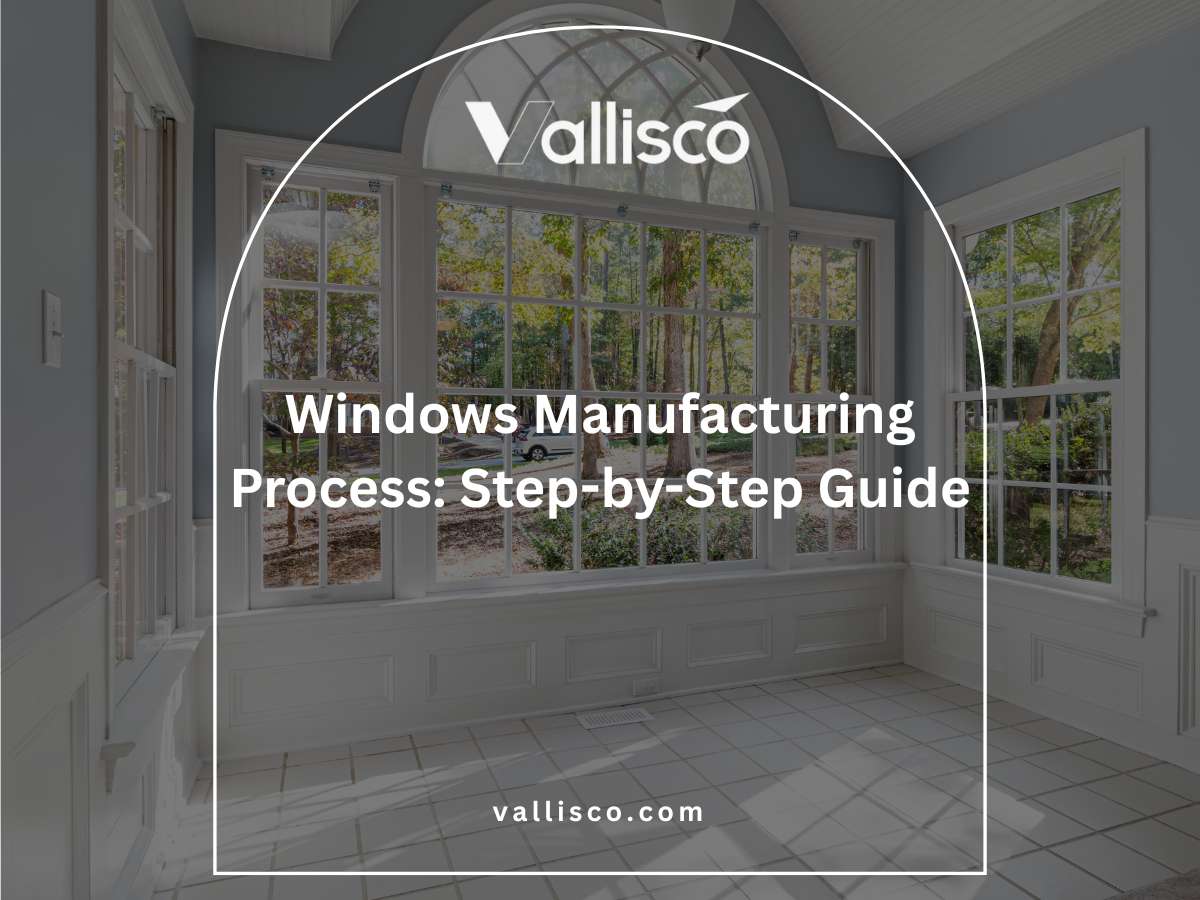On a recent project, I sat with a hotel owner who was frustrated. They had replaced their windows only a few years earlier, but poor choices meant higher costs. I realized again how much windows impact a property’s success.
If you’ve ever faced similar challenges, you know how important it is to get it right from the start.
I’ve guided many clients in villas, inns, and greenhouses. My experience comes from handling real installations, solving problems, and seeing firsthand what works in different climates. That’s why our advice is practical and reliable.
This article will walk you through 11 house window types. We’ll show you how each one works, when to use them, and what benefits they bring. By the end, you’ll have the clarity you need to make the best choice.
Windows are more than glass and frames, they set the tone for the whole building.
So let’s get down to it!
Quick Comparison Chart
Choosing the right window for a property can save time, cost, and energy. Each type has its own features, benefits, and best use cases. This table gives you a clear snapshot before we explore each one in detail.
| Window Type | Key Features | Benefits | Best For |
| Casement Windows | Hinged at the side, open outward | Good airflow, tight seal, easy operation | Villas, houses, hotels in breezy areas |
| Awning Windows | Hinged at the top, open outward | Ventilation during rain, privacy, airflow | Bathrooms, kitchens, rainy climates |
| Sliding Windows | Move horizontally on a track | Space-saving, wide view, easy to use | Modern houses, hotels, greenhouses |
| Double-Hung Windows | Two sashes, both can slide up or down | Flexible airflow, classic look, easy cleaning | Traditional houses, inns, multi-story homes |
| Single-Hung Windows | One fixed sash, one movable sash | Cost-effective, durable, easy to maintain | Budget projects, simple residential builds |
| Bay Windows | Three-window design, extends outward | Adds light, space, and curb appeal | Villas, B&Bs, larger living spaces |
| Bow Windows | Four or more panels forming a curve | Elegant style, panoramic view, natural light | Hotels, luxury villas, spacious homes |
| Picture Windows | Fixed, large glass panel | Maximum light, clear view, low maintenance | Greenhouses, living rooms, scenic areas |
| Louvered (Jalousie) Windows | Multiple slats, adjustable tilt | Strong airflow, low cost, simple replacement | Tropical climates, budget-friendly builds |
| Hopper Windows | Hinged at bottom, open inward | Tight seal, compact, improves ventilation | Basements, bathrooms, small spaces |
| Skylight Windows | Installed in roof or ceiling | Natural daylight, energy saving, modern look | Villas, hotels, B&Bs with dark interiors |
Each window type serves a different purpose and offers practical value. Keep reading below for a detailed review of all 11 house window types.
1. Casement Windows
Casement windows are used in many villa and hotel projects, and they never fail to impress. They’re simple in design but offer real value in airflow, comfort, and long-term use. If you’re considering this type, here’s what you need to know:
Features
- Side Hinges: Casement windows are hinged on the side and swing outward like a door. This makes them flexible for directing airflow into a room.
- Crank Handle Operation: Most casement windows open with a crank handle. The mechanism is easy to use, and it allows precise control of how wide you want the window open.
- Tight Sealing: When closed, the sash presses firmly against the frame. This creates a strong seal that keeps out drafts, dust, and water.
- Variety of Materials: You can find casement windows in aluminum, wood, or uPVC frames. Each material offers different durability and style options for your project, and companies like Vallisco manufacture them to meet both residential and commercial needs.
Key Benefits
- Improved Airflow: Because they open outward, casement windows catch side breezes and direct fresh air into a room. This can help with natural ventilation in hot climates.
- Energy Savings: The tight seal reduces heat loss in colder regions and keeps cool air inside in warmer areas. Over time, this adds up to cost savings on energy bills.
- Easy to Clean: Since they open wide, both sides of the glass can be cleaned from inside the building. This is especially helpful for multi-story homes and hotels.
- Good Security: The locking system is often embedded in the frame, which makes it harder for intruders to force them open. This gives added peace of mind for owners.
Bottom Line
Casement windows are one of the most practical choices if you want both airflow and energy efficiency. I often recommend them for villas, B&Bs, and hotels that value comfort and reliability in daily use. They work well in both Southeast Asian tropical climates and European seasonal settings.
If you’re looking for a window type that combines function with a clean look, casement windows are a safe place to start. They don’t just serve a single purpose; they help you balance comfort, security, and cost across different projects.
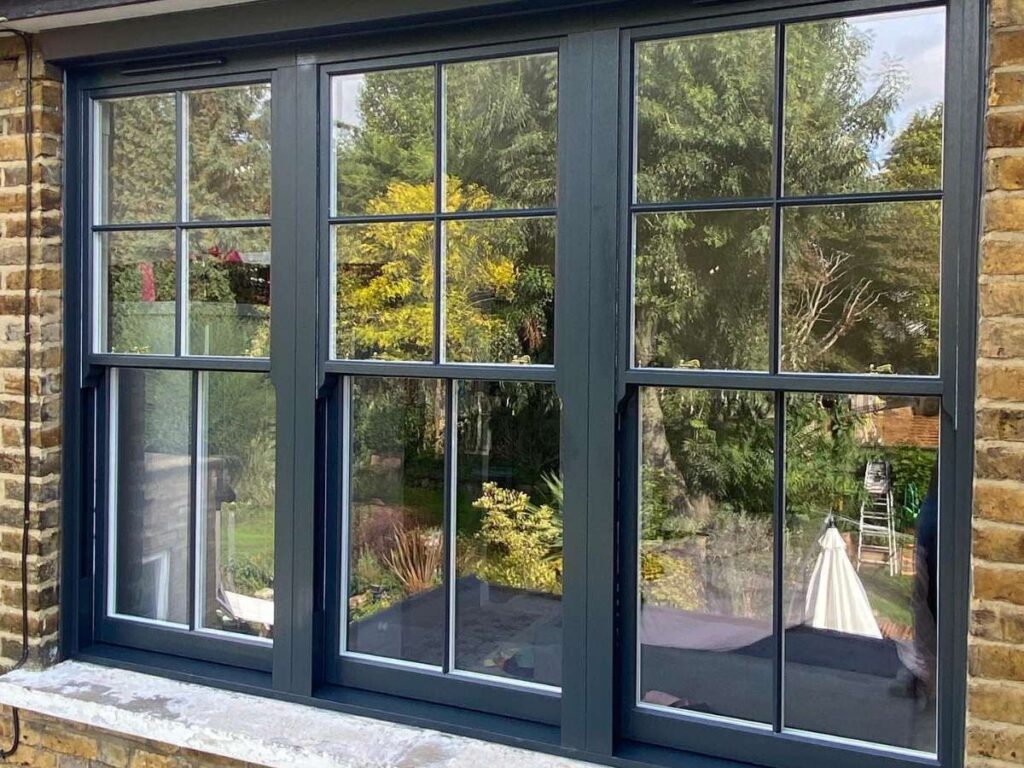
2. Awning Windows
I’ve worked with many clients who chose awning windows for kitchens, bathrooms, and even guest rooms. They may look simple, but they are one of the most practical options in both rainy and tropical climates. If you’re weighing this type for your project, here’s a clear picture of how they work:
Features
- Top Hinges: Awning windows are hinged at the top and swing outward from the bottom. This design lets air in while keeping rain out, which makes them a reliable choice for wet seasons.
- Outward Opening: Because they open outward, they don’t take up interior space. This makes them suitable for rooms where space is tight, such as bathrooms or small offices in a hotel.
- Glass and Frame Choices: Like other window types, awning windows come in aluminum, wood, and uPVC frames. Each material can match different architectural needs, whether modern villas or traditional inns.
- Flexible Sizes: They are available in small to medium sizes and can be installed higher on a wall. This gives natural light while still keeping privacy for guests or residents.
Key Benefits
- Rain Protection: Even when it rains, you can leave an awning window open. The outward angle acts as a shield, allowing ventilation without water coming inside.
- Ventilation in Humid Areas: I’ve seen how well these windows work in Southeast Asia where humidity is high. They let in air circulation that helps reduce dampness in bathrooms or kitchens.
- Energy Efficiency: By placing them higher on the wall, they allow light and air without direct heat gain. This small detail can support your energy management strategy in larger properties.
- Added Privacy: Since they can be set higher than eye level, awning windows give privacy while still letting in air and daylight. This works especially well for hotels or guesthouses.
Bottom Line
Awning windows are a dependable option for businesses that need both function and protection. They are particularly well-suited to wet and tropical climates, but they also work well in cooler regions where fresh air is important. I often suggest bathrooms, kitchens, or any area that benefits from natural ventilation.
For villa, hotel, and B&B owners, awning windows can be a smart addition to your overall window plan. They bring in light, maintain privacy, and reduce moisture problems in small or large spaces alike.
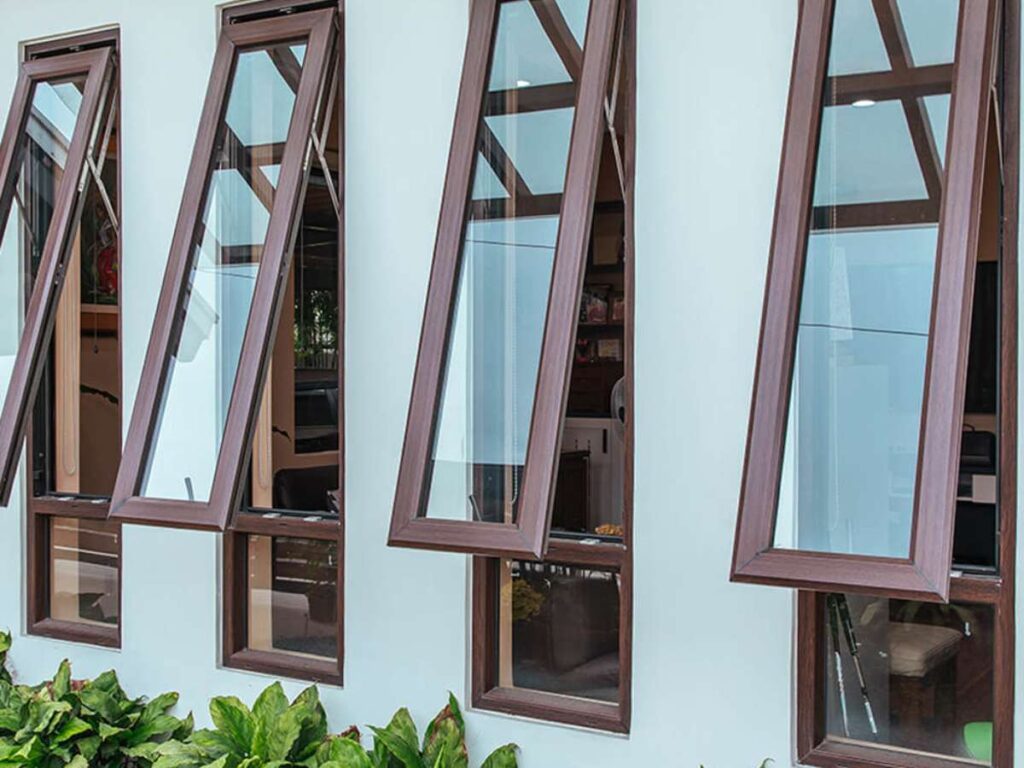
3. Sliding Windows
Working on projects where space was limited, turned out that sliding windows are a perfect fit. They’re practical, easy to use, and often a good match for modern buildings. If you’re considering them, here’s what you need to know.
Features
- Horizontal Operation: Sliding windows move sideways on a track instead of swinging open. This means they don’t interfere with furniture placement or pathways.
- Simple Design: The frame usually holds two panels, with one fixed and one movable. In larger spaces, you can have more panels for a wider opening.
- Material Options: Sliding windows are widely available in aluminum, wood, and uPVC. Each offers different looks and levels of durability, which lets you match them to your project style.
- Track System: They operate on a track at the top and bottom. A well-built track ensures smooth sliding and reduces wear, which is important for long-term use in busy properties.
Key Benefits
- Space Saving: Because the panels slide instead of opening outward or inward, you save valuable space. This makes them ideal for villas and hotels where layouts are tight.
- Wide View: Sliding windows usually have large glass panels. This gives guests or homeowners an open view of gardens, pools, or surrounding landscapes.
- Low Maintenance: Fewer moving parts mean fewer repairs. With proper cleaning of the track, sliding windows can last for years with minimal upkeep.
- Ease of Use: I’ve noticed that clients appreciate how easy they are to open and close. Even in large installations, the movement is smooth and doesn’t require much effort.
Bottom Line
Sliding windows are one of the most practical options for modern builds and renovations. They save space, provide wide views, and deliver simple operation that works well for daily use in both Southeast Asian and European settings.
For owners of villas, B&Bs, and hotels, sliding windows can be a smart addition where you want light, openness, and ease of use without the hassle of heavy maintenance. They fit well in living rooms, guest rooms, or even greenhouses where visibility and airflow matter.
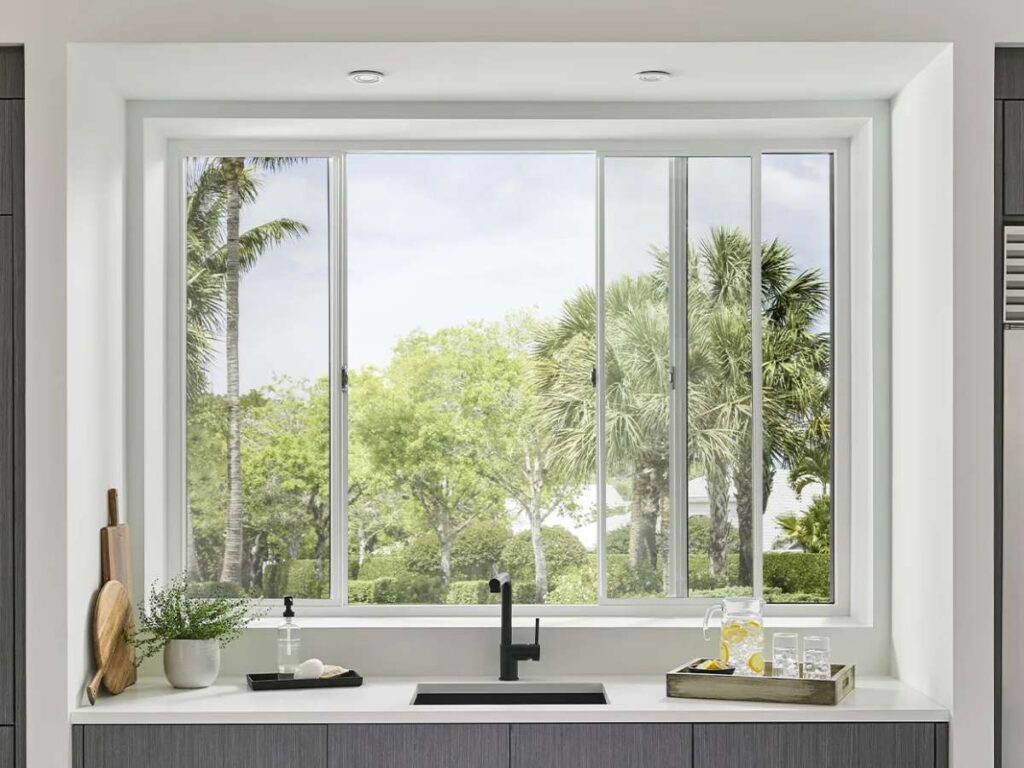
4. Double-Hung Windows
I’ve worked on several projects where owners wanted both a traditional look and practical function. Double-hung windows were often the answer. They have a classic design, but they also offer flexibility that works well in many types of properties.
Features
- 2 Operable Sashes: Both the top and bottom sashes can move up and down. This allows you to open either one or both, depending on how much air circulation you want.
- Vertical Sliding Mechanism: The panels move within the frame instead of swinging outward or inward. This design saves space inside and outside the building.
- Balance System: Many double-hung windows use springs or weights to keep the sashes steady. This makes operation smoother and safer, even for larger frames.
- Custom Sizes and Materials: They can be built in a range of sizes with wood, aluminum, or uPVC frames. This gives you flexibility to match the style of your villa, inn, or hotel.
Key Benefits
- Better Ventilation Control: By lowering the top sash and raising the bottom sash, you can create a natural airflow cycle. Warm air escapes at the top while cool air comes in from below.
- Easy Cleaning: The sashes can often tilt inward. This makes it easier to clean both sides of the glass from inside the building, which is useful for multi-story hotels and inns.
- Timeless Look: I’ve noticed that many clients choose double-hung windows because of their traditional style. They fit well with both older buildings and newer projects that aim for a classic design.
- Durability: With proper maintenance, double-hung windows can last for decades. The design has been proven reliable for generations, which gives confidence in long-term use.
Bottom Line
Double-hung windows are a strong choice if you want ventilation control and a traditional design. They combine appearance with practicality, which makes them a good option for both historic buildings and new projects aiming for a classic touch.
For villa owners, hotel managers, or B&B operators, these windows can bring value to both form and function. They give you flexibility in airflow, easier maintenance, and a look that appeals to guests while standing the test of time.
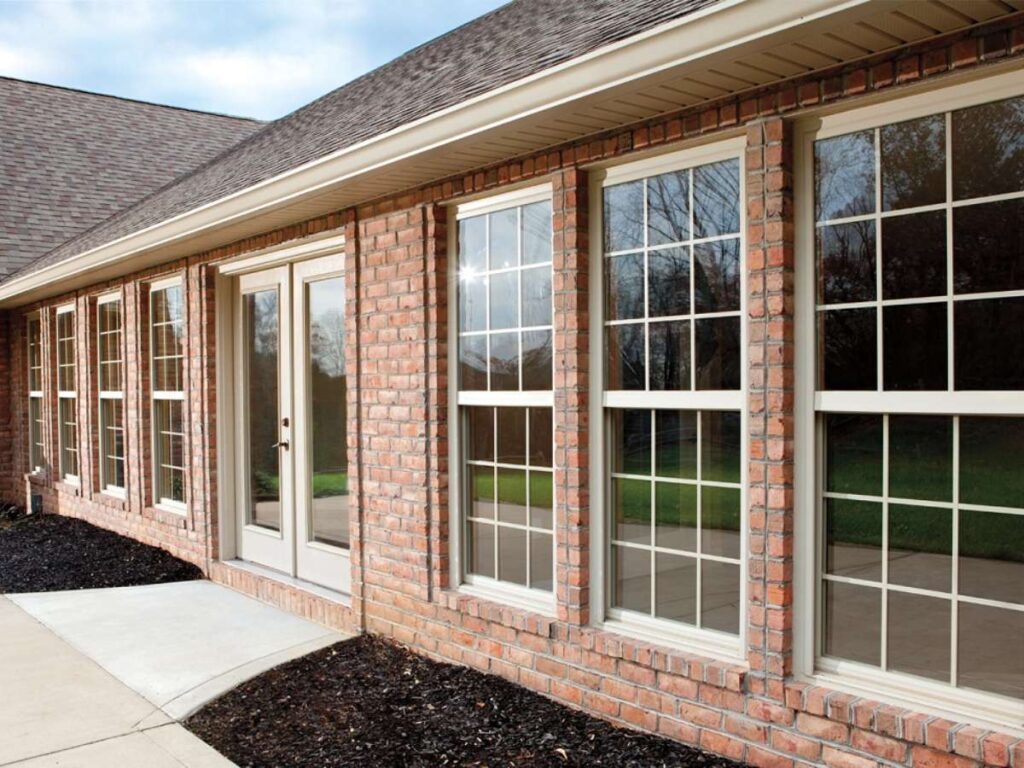
5. Single-Hung Windows
I’ve seen many projects where budget and durability were the main concerns. In those cases, single-hung windows worked well. They keep things simple, while still offering good performance for everyday use.
Features
- Fixed Top Sash: The top sash is fixed in place and does not move. Only the bottom sash slides upward, which makes the design more straightforward.
- Vertical Operation: The bottom sash moves up and down inside the frame. This provides basic ventilation without requiring extra space inside or outside the room.
- Simple Hardware: With fewer moving parts compared to double-hung windows, the hardware is easier to install and maintain. This makes them a reliable option for larger projects.
- Material Choices: Single-hung windows are widely available in aluminum, uPVC, or wood. Each option allows you to match your project’s look and budget needs, and manufacturers like Vallisco supply them in different finishes to fit larger builds.
Key Benefits
- Cost-Effective: Because they have fewer moving parts, single-hung windows are usually more affordable. This makes them a good fit for large-scale builds like hotels or multi-unit villas.
- Durability: I’ve noticed that with fewer mechanisms, there’s less that can break down over time. This adds to the lifespan of the window and reduces service calls.
- Energy Efficiency: The fixed top sash helps create a tighter seal. This improves insulation and can reduce cooling or heating costs across your property.
- Low Maintenance: Cleaning and maintenance are simpler. Owners can spend less time dealing with repairs and more time focusing on their core business.
Bottom Line
Single-hung windows are a straightforward option that balances performance and cost. They don’t offer as much ventilation flexibility as double-hung windows, but they make up for it in price, durability, and efficiency.
For villa, hotel, or B&B projects, single-hung windows can be the right fit if you want long-lasting windows without pushing the budget. They are simple, reliable, and practical for properties that need function without added complexity.

6. Bay Windows
I’ve walked into many villas and hotels where bay windows completely changed the feel of the room. They bring in light, create space, and give a touch of elegance that guests notice right away. If you want windows that make a statement while still being practical, bay windows are worth considering.
Features
- Three-Panel Design: Bay windows are usually made up of three panels. A large fixed window is in the center, with two smaller angled windows on the sides.
- Outward Projection: The whole unit extends outward from the wall. This design creates a small nook or ledge inside the room, which can be used for seating or decoration.
- Angle Options: The side windows are often set at 30, 45, or 60 degrees. The angle you choose will affect how much space the bay adds inside the room.
- Custom Materials and Sizes: Bay windows can be built with wood, aluminum, or uPVC. Sizes vary widely, which gives you flexibility depending on the type of property you’re building or renovating.
Key Benefits
- More Natural Light: With three panels, bay windows let in more daylight than standard flat windows. This can reduce the need for artificial lighting during the day.
- Extra Space: The outward extension adds usable space inside. I’ve seen clients use this area as a reading nook, display space, or even extra seating in guest rooms.
- Improved Views: The angled design offers a wider view of the outside. This is especially valuable in villas or hotels located near gardens, pools, or scenic landscapes.
- Boosted Property Value: Bay windows often increase the perceived value of a property. Their design makes a strong impression and adds architectural interest.
Bottom Line
Bay windows are a smart choice if you want to add both style and function to your property. They bring in light, provide extra space, and create views that guests will remember.
For villas, hotels, and B&Bs, bay windows can be more than just a design feature. They can set rooms apart, make spaces more inviting, and leave a lasting impact on visitors.
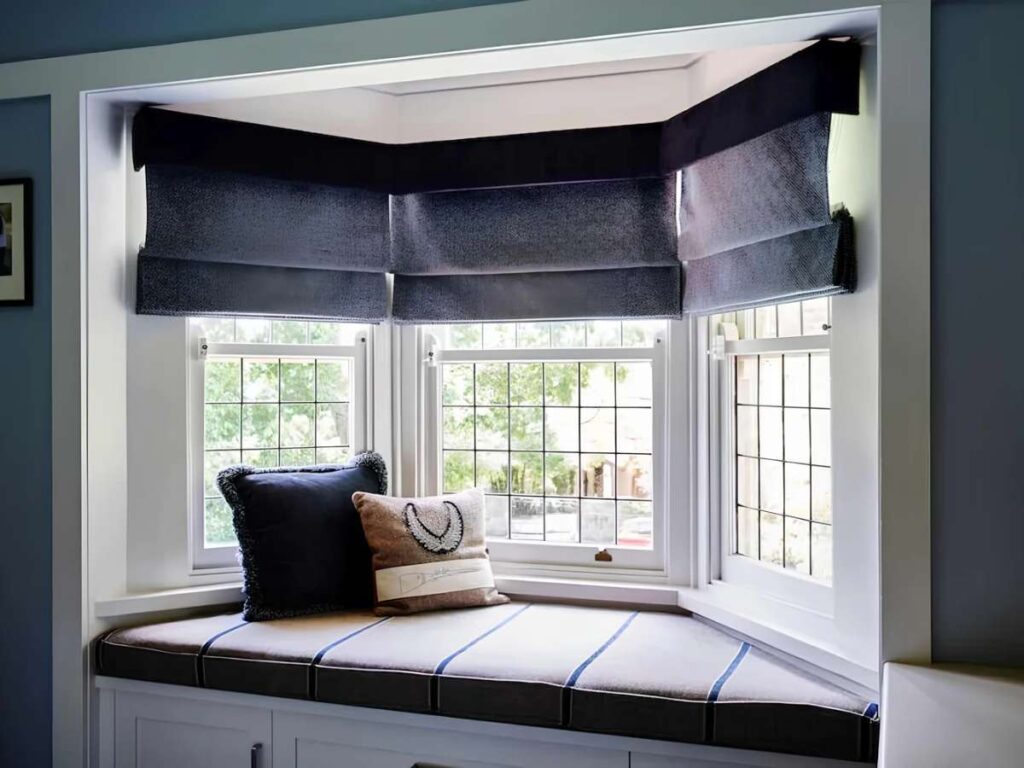
7. Bow Windows
I’ve noticed that whenever bow windows are added to a property, the space instantly feels more open and elegant. They use several panels instead of just three, which gives a softer curve and a more modern look. If you’re aiming to create a standout feature for your villas or hotels, bow windows are worth serious thought.
Features
- Four or More Panels: Unlike bay windows, bow windows use four, five, or even six panels. The extra panels create a smoother curved shape along the wall.
- Outward Curve: The design projects outward in a gentle arc. This makes the window feel more natural and adds depth to both the inside and outside of the property.
- Large Glass Areas: Because of the multiple panels, bow windows let in a great deal of light. They are usually fixed panels, but some can be customized to include operable sections.
- Flexible Width: Bow windows can span wider sections of a wall than bay windows. This makes them suitable for larger rooms, lobbies, or suites.
Key Benefits
- Panoramic Views: The curved design offers a wider angle of view. Guests in a villa or hotel suite can enjoy scenery without interruption, which enhances their experience.
- More Natural Light: With multiple glass panels, bow windows brighten up even large spaces. I’ve seen them transform dark lounges and common areas into warm, inviting spaces.
- Elegant Appearance: Bow windows add an upscale feel to properties. Their design often becomes a focal point, boosting the overall look of the building inside and out.
- Extra Space Inside: The outward projection creates more interior space. Owners often use this for seating areas or decorative setups in guest rooms or lounges.
Bottom Line
Bow windows are an excellent choice if you want to combine light, space, and style in one feature. They work especially well in properties that benefit from natural surroundings, such as villas with garden views or hotels by the sea.
For business owners, bow windows don’t just improve aesthetics. They can raise the value of a property, set rooms apart, and create guest experiences that feel premium without being overly complicated to maintain.
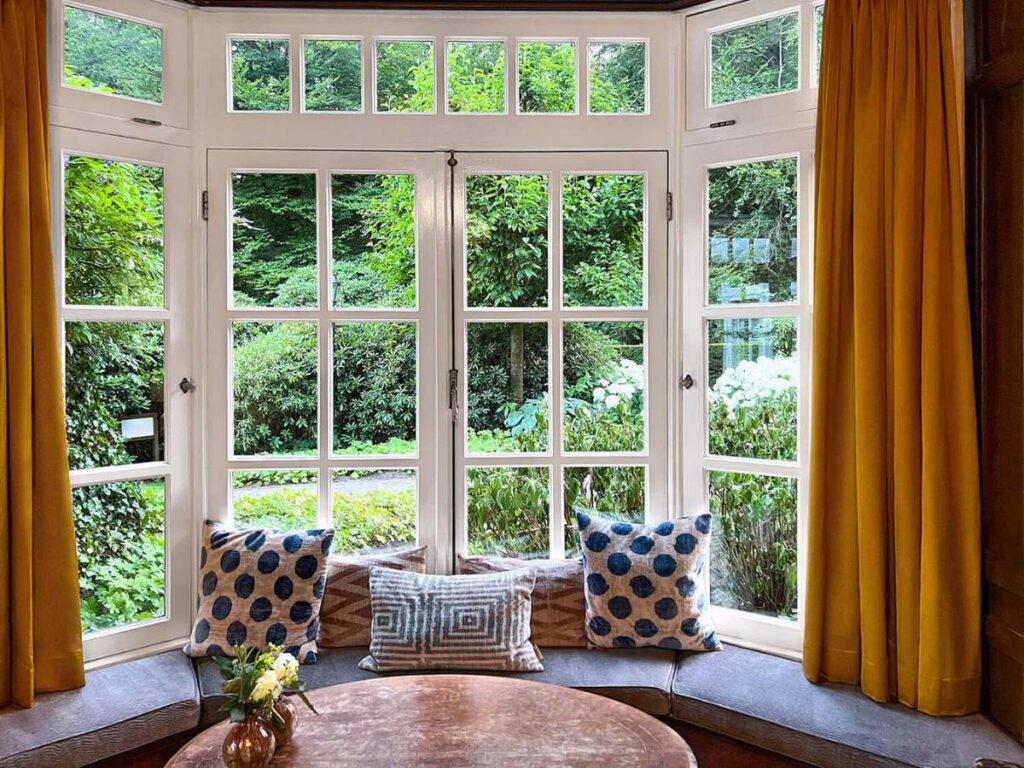
8. Picture Windows
I’ve seen picture windows transform plain walls into stunning focal points. They don’t open or move, but they frame views like a piece of art. If your project is in a scenic location, this type of window can have a strong impact.
Features
- Fixed Glass Panel: Picture windows are made of one large, fixed pane of glass. Since they don’t open, they provide an unobstructed view outside.
- Variety of Sizes: They can be built in small, medium, or floor-to-ceiling sizes. This flexibility lets you use them in both compact guest rooms and large hotel lobbies.
- Frame Options: The frames are usually slim to maximize the glass area. Materials like aluminum and uPVC are common, keeping the look clean and modern.
- Energy Glass Choices: Many picture windows use insulated or low-emissivity glass. This helps regulate temperature and reduces glare, which is important in tropical or sunny locations.
Key Benefits
- Uninterrupted Views: With no sashes or dividers, picture windows give a full view of gardens, pools, or natural landscapes. I’ve seen them used effectively in villas overlooking the sea.
- Natural Light: These windows allow maximum daylight to enter. This can brighten up large spaces and reduce the need for artificial lighting during the day.
- Energy Efficiency: Because they are sealed and don’t open, picture windows have fewer air leaks. This helps maintain indoor comfort and can lower energy costs.
- Low Maintenance: With no moving parts, repairs are rare. Cleaning is simple, which makes them practical for hotels or B&Bs managing multiple rooms.
Bottom Line
Picture windows are an excellent choice if you want to showcase views and bring in more daylight. They are simple, practical, and deliver strong results without the need for complex mechanisms.
For villas, hotels, and guesthouses, these windows can become a design highlight. They frame the outside like a living painting, adding value and appeal to spaces where scenery is part of the experience.
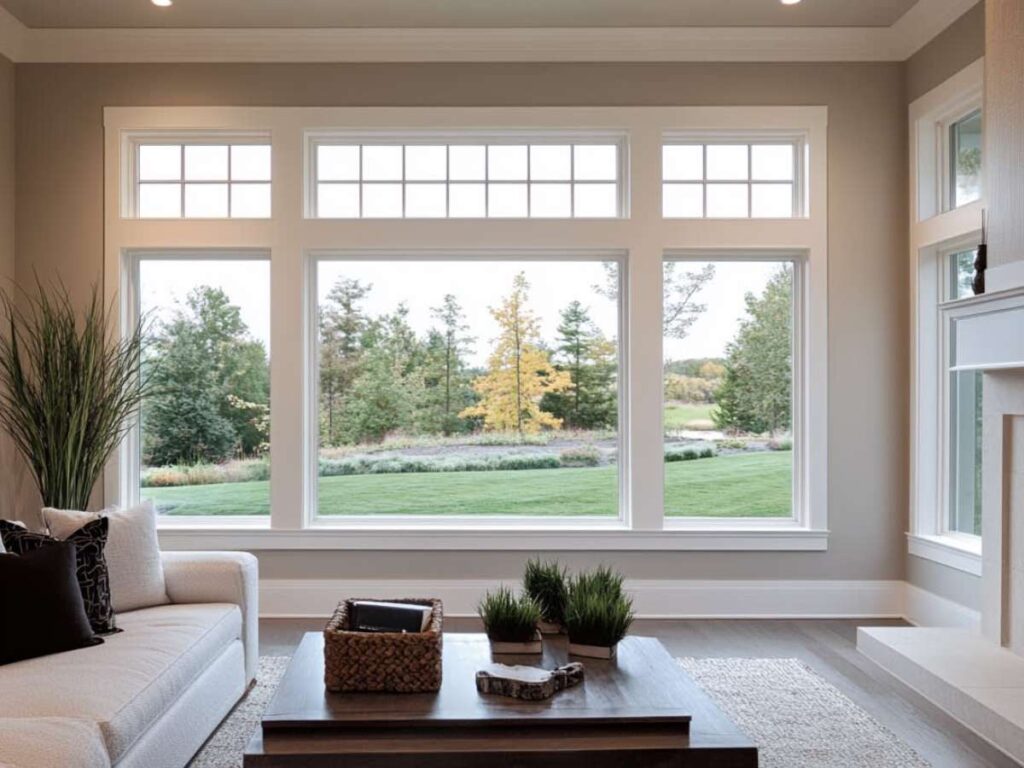
9. Louvered (Jalousie) Windows
I’ve seen louvered windows used a lot in tropical projects, especially in villas and greenhouses. They allow strong airflow, which is important in hot and humid climates. If you’re managing properties in these regions, this type of window can be very practical.
Features
- Glass Slats: Louvered windows are made of horizontal glass slats set in a frame. These slats tilt open or closed at the same time with a crank or lever.
- Adjustable Angles: The slats can be tilted at different angles. This lets you control the amount of air and light entering the room with precision.
- Outward or Inward Airflow: Because of the angled slats, you can direct breezes into space. This makes them especially useful in tropical areas where airflow is essential.
- Affordable Materials: The glass slats are often paired with aluminum or uPVC frames. The design is cost-effective, making it a good option for large-scale builds.
Key Benefits
- Strong Ventilation: Louvered windows are one of the best choices for airflow. I’ve worked with clients who used them in greenhouses and villas to keep spaces cooler without relying only on air conditioning.
- Budget-Friendly: They are usually less expensive than other types of windows. For hotels or B&Bs managing multiple units, this helps keep construction or renovation costs down.
- Easy Replacement: If a glass slat gets damaged, it can be replaced individually. This saves time and cost compared to replacing a full window panel.
- Sun and Privacy Control: By adjusting the angle of the slats, you can reduce glare while still keeping ventilation. The angled design also gives a level of privacy to occupants.
Bottom Line
Louvered windows are a practical and affordable solution for projects in hot and humid areas. They combine airflow, flexibility, and cost savings, which makes them a strong choice for business owners managing properties in Southeast Asia or similar climates.
For villas, B&Bs, or even greenhouses, these windows can make day-to-day operations easier. They offer reliable performance, simple maintenance, and a way to keep spaces comfortable for guests and residents.

10. Hopper Windows
I’ve often recommended hopper windows for basements, bathrooms, or small utility rooms in villas and hotels. They may not be the largest type, but they provide solid ventilation and a tight seal where it matters most. If you’re working on a project that needs compact but effective windows, this type is worth looking at.
Features
- Bottom Hinges: Hopper windows are hinged at the bottom and open inward from the top. This design makes them different from awning windows, which open outward.
- Inward Tilt: The sash tilts into the room when opened. This helps direct airflow upward and also makes the inside glass easier to clean.
- Compact Design: They are usually small to medium in size. This makes them a good fit for basements, bathrooms, or any space where larger windows are not practical.
- Sealed Closure: When shut, hopper windows press tightly against the frame. This creates a reliable seal that blocks drafts, dust, and moisture.
Key Benefits
- Ventilation in Tight Spaces: Hopper windows are excellent for letting fresh air into small rooms. I’ve seen them used effectively in guest bathrooms and hotel laundry rooms.
- Energy Efficiency: The tight seal reduces air leakage. This keeps rooms more comfortable and can help lower heating or cooling costs over time.
- Ease of Cleaning: Since the sash tilts inward, cleaning the glass is simple. Staff can clean them safely without needing outside access.
- Moisture Control: Their design helps with airflow, which reduces dampness and mold risk in basements or other enclosed areas.
Bottom Line
Hopper windows are a reliable choice when you need ventilation in smaller spaces without sacrificing efficiency. They may not be as visually striking as bay or bow windows, but they serve a very specific purpose well.
For villa, hotel, or B&B owners, these windows can solve practical challenges in basements, bathrooms, or other compact rooms. They combine ease of use, energy savings, and durability in a simple design that gets the job done.

11. Skylight Windows
I’ve seen skylight windows make a dramatic difference in villas and hotels where natural light was limited. They bring sunlight directly from above, brightening up dark areas that standard wall windows can’t reach. If you’re managing properties with large or shaded interiors, skylights can be a strong addition.
Features
- Roof Placement: Skylight windows are installed in the roof or ceiling. This unique position allows them to capture daylight directly from above.
- Fixed or Operable: Some skylights are fixed and only provide light, while others can be opened to allow ventilation. Operable versions are especially useful in humid climates.
- Variety of Shapes and Sizes: They can be rectangular, circular, or custom-shaped. This flexibility makes them suitable for guest rooms, lobbies, and even bathrooms.
- Energy Glass Options: Many skylights use double glazing or tinted glass. These features help reduce glare, manage heat, and improve insulation.
Key Benefits
- Increased Natural Light: Skylights brighten spaces that standard windows can’t. I’ve worked on projects where they turned dark lobbies or corridors into welcoming areas filled with daylight.
- Energy Savings: By bringing in more natural light, skylights can reduce the need for artificial lighting during the day. This adds up to cost savings across a property.
- Ventilation Option: Operable skylights allow hot air to rise and escape. This is especially helpful in attics or upper floors of villas and hotels in warmer regions.
- Modern Appeal: Skylights add a contemporary touch to interiors. Guests often notice and appreciate the effect, which can raise the overall impression of your property.
Bottom Line
Skylight windows are a smart way to add natural light and style to spaces that would otherwise feel closed off. They work well in both modern and traditional properties, and they offer flexibility in design and function.
For villas, hotels, and B&Bs, skylights can enhance guest comfort, reduce energy costs, and give your property a modern edge. They’re more than just a window in the roof, they’re a feature that transforms the feel of the entire space.
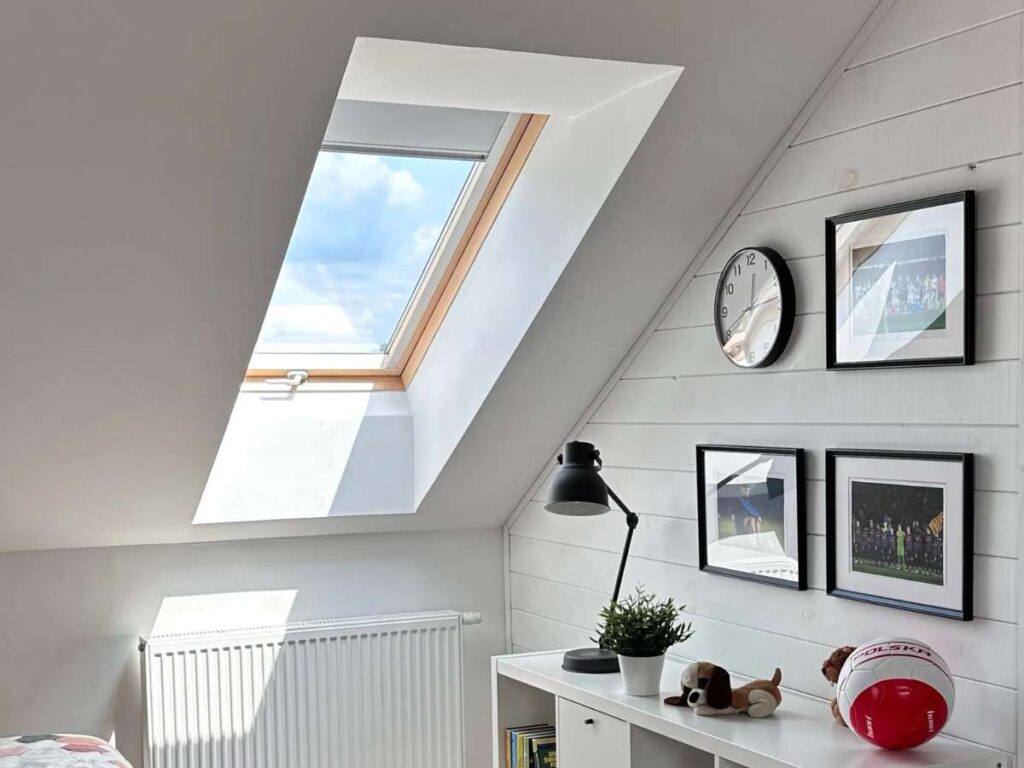
4 Factors to Consider When Buying House Windows
I’ve worked with many owners and project teams who focus only on price when choosing windows. But in my experience, other factors matter just as much, if not more. If you want windows that last and perform well, here are a few things to keep in mind.
- Climate and Location: The climate where your property sits should guide your window choice. Hot and humid regions may need strong ventilation, while colder areas benefit more from insulation. Matching the window type to your location saves money and prevents problems later.
- Energy Efficiency: Energy costs add up quickly in hotels, villas, and B&Bs. Choosing windows with insulated glass or tight sealing can reduce those bills. It’s not just about comfort; it’s also about long-term savings for your business.
- Maintenance and Durability: I’ve seen how much time and money can go into window upkeep. Some types, like sliding or single-hung windows, are easier to maintain than others. Think about the daily use in your property and pick windows that your team can clean and maintain without too much effort.
- Aesthetic and Function: Windows affect both the look and the feel of a property. Large feature windows, like bay or picture styles, can set your building apart, while smaller options add practical ventilation. Balance the design with how the windows will be used day-to-day.
Conclusion
That story of the hotel owner left with drafty, costly rooms had a clear ending: they replaced their windows, and guests finally felt the difference.
Your project deserves the same outcome.
These 11 window types show that no single option works for every property, but the right match makes all the difference. From energy efficiency to design, the right choice will pay off for years.
Use this article as your starting point, then move forward with confidence.
If you’re ready to take the next step, connect with Vallisco, a manufacturer that delivers dependable window solutions. Contact us today!
More Guides and Tips to Explore
For more helpful content, explore our collection of recommended reads:
Still haven’t found what you’re looking for? Don’t hesitate to contact us. We’re available around the clock to assist you.



